Posted on 20 April 2023
Te Au o Te Moana – 2023 conference highlights
- News
- 11 Minutes to read
Connecting Te Au o Te Moana with the voices of our researchers, co-developers, and Māori partners resonated strongly across the Sustainable Seas 2023 three-day conference.
Matua Joe Harawira (Ngāti Awa, Ngāi te Rangi, Ngāti Maniapoto, Tūhourangi), Sustainable Seas Kāhui Māori, framed the conference opening with a clear call.
We are connected to the heartbeat of the ocean and must use our collective knowledge, perspectives, and wisdoms to give energy and integrity to the many different water bodies of the natural world. Matua Joe Harawira
Held in Te Whanganui-a-Tara/Wellington over three days at the end of March, the Sustainable Seas National Science Challenge conference, Te Au o Te Moana, was the first opportunity since 2018 for our researchers, co-developers, and Māori partners to share their knowledge across the key themes of a Blue Economy, Te Ao Māori, and Ecosystem-based Management.
Whakatutuki (weaving findings from all projects for greatest impact) shaped the agenda, as the Challenge continues its work with end-users to co-develop tools and resources that share the knowledge and experience generated through nearly a decade of research.
Day one – pathways to a blue economy that sustains people and planet
The voice, the sounds, the cry of the ocean refers to the ocean tides, to the natural sounds of the ocean's rhythms. It denotes a voice into what is going on above, within and beneath the waves. Matua Joe Harawira
Rimurimu/seaweed, pātangaroa/sea stars, and kaimoana/seafood and their blue economy potential starred on day one of the conference. Researchers, co-developers, and Māori partners showed the possibilities and pathways to a blue economy that’s Treaty-led, sustainable, intergenerational, prosperous, and inclusive. Presenters spoke of promising products.
Nick Lewis, University of Auckland showed the potential of evolving, emerging, and prospective industries and potential models for transitioning to a blue economy. This includes understanding economies, getting to grips with the sustainability challenge, and researching local and global marine economies.
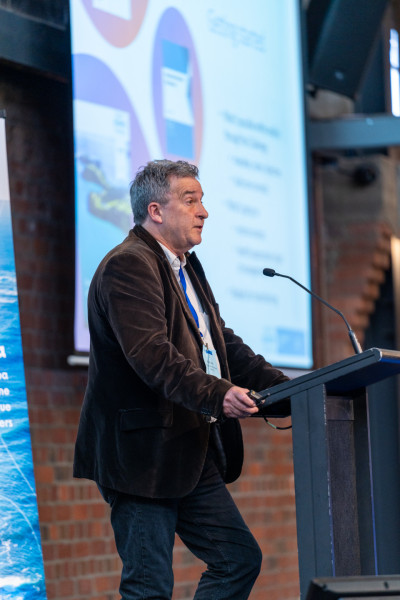
Dr Nick Lewis, University of Auckland
Jason Mika (Tūhoe, Ngāti Awa, Whakatōhea, Ngāti Kahungunu), University of Waikato, and John Reid (Ngāti Pikiao, Tainui), University of Canterbury, posed questions, offered answers, and outlined case studies on indigenising the blue economy. They highlighted the employment, enterprise, and economic opportunities for Māori, today and for future generations.
Cerasela Stancu, Envirostrat, talked about different types and ways of investing in a restorative blue economy.
Maru Samuels (Ngāi Te Rangi, Ngāi Takoto, Te Rarawa), Iwi Collective Partnership, talked about transforming fisheries management in Aotearoa through tikanga and mātauranga. “We have the solutions for fisheries management for a new way of thinking, a new approach, for fisheries in Aotearoa. Throw us the ball and let us run it. The country will benefit.”
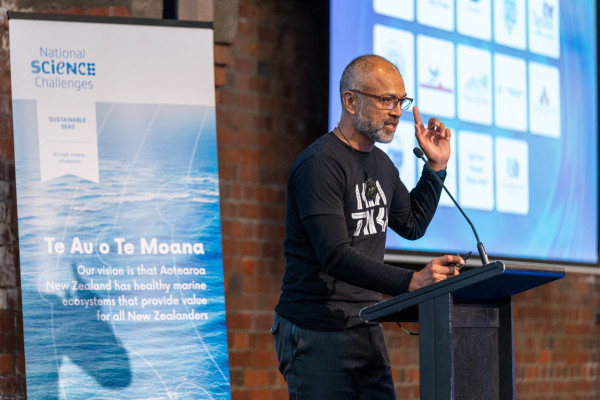
Maru Samuels, Chief Executive Officer, Iwi Collective Partnership
Julie Hall, Director Sustainable Seas, introduced principles to support a blue economy for Aotearoa New Zealand.
Panellists from Waikato University, the Sustainable Seas Governance Group, the Auckland Economic Strategy Branch of MBIE, and AgriSea New Zealand discussed the question: “what could a blue economy look like?”
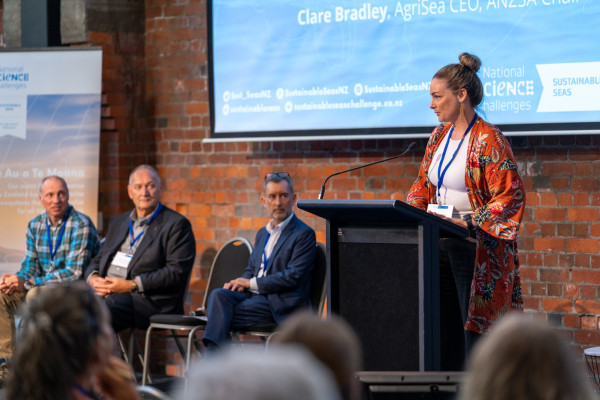
L to R: Professor Conrad Pilditch, University of Waikato, Ta Mark Solomon, Sustainable Seas Governance Group, Andy Hill, MBIE, and Clare Bradley, Chief Executive Officer, AgriSea New Zealand
The afternoon panel discussion with panellists from ANZ Sustainable Finance, Sealord, and KPMG talked strategies and approaches to landing the blue economy research programme to better use marine resources.
Day two – observation, connection, and tikanga can lead us towards a vital and exciting future
A sense of the state of the ocean and our responsibility and relationship to the life force, the mauri, to the spirit, the wairua, to the prestige, the mana, and to the sacrality. The tapu within. Matua Joe Harawira
Day two of the conference was a koha/gift to attendees – unwrapping insights, indigenous knowledge, values, observation, poetry, and waiata. Morning presentations were summed up nicely by Ian Ruru (Te Aitanga a Mahaki, Ngāi Tai, Whakatohea, Ngāti Porou) as ‘stuff you can’t Google’.
Pelika Andrade from Hawai’i began the day speaking about indigenous literacy – reading our environment, listening to our places, and listening to our natural resources so we can start to make decisions on how we live.
“Observe, don’t assume cause and effects. Scientists are also trained this way. The shared values are there.”
Teina Boasa-Dean (Ngāi Tūhoe) shared the Tūhoe science of sensing with words woven around tikanga and mātauranga Māori, and the mauri and mana of wai. She showed the importance of observation and listening before doing anything else.
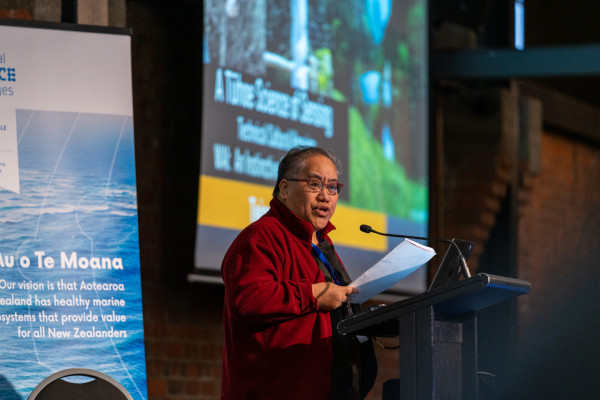
Teina Boasa-Dean, BHW Lands Trust
A session on Mauri Tangata began with Beth Tupara-Kātene (Ngāi Tāmanuhiri) and Te Pūoho Katene (Ngāti Toa, Ngāti Whātua, Ngāti Tama).
“To be mātauranga driven is to be driven by our hapū and their intimate connection with the moana.”
Te Rerekohu Tuterangiwhiu (Ngāpuhi, Taranaki, Ngāti Ranginui, Tainui), of Cawthron Institute spoke about using traditional practices to inform a hapū-based blue economy.
“What are those taonga that have whakapapa to here that we can use as an anchor point for understanding aquaculture moving forward? It’s no use having mātauranga Māori in our kete of tools if we don’t reach for it.”
In the afternoon of day two participants saw and heard incredible stories of people, place, and resilience.
A session on co-developing tools to enable Aotearoa-wide kaitiakitanga and ecosystem-based management was led by Lara Taylor (Te Arawa, Ngāti Kahungunu, Kāi Tahu ki Murihiku), of E Oho! Using the tool, Mentimeter, Lara asked the audience, “What would it take to restore te mana o te moana?” Consistent themes of unified action, collaboration, and co-development emerged, along with connection to each other, the moana, and ki uta ki tai (kaitiakitanga from the mountains to the sea).
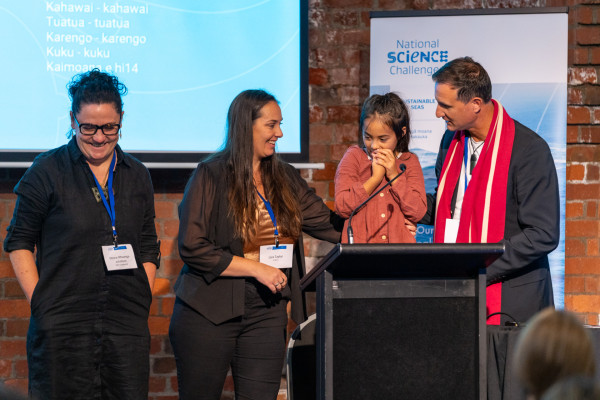
L to R: Desna Whaanga-Schollum, Lara Taylor, Hinewai, and Dr Dan Hikuroa, E Oho!
The last part of the day gave brimming brains an opportunity to pause, imagine, tell stories, and re-connect with what matters.
Waiaria Rameka (Ngāti Tūwharetoa, Ngāti Raukawa) and Kelly Ratana (Te Arawa) from Ngā Tohu Collective ran a powerful workshop and interactive session on mauri — with ways to embed new thinking generously shared, including the koha of waiata.
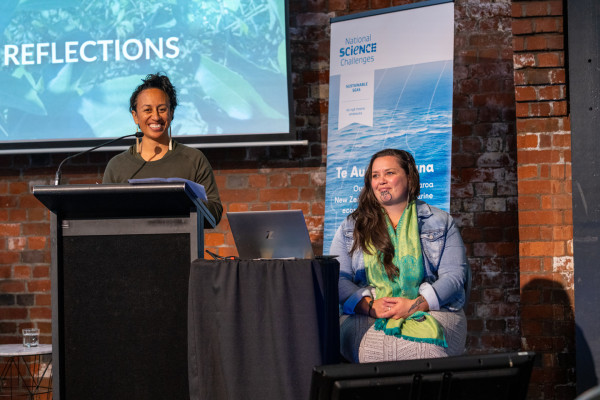
L to R: Wairaria Rameka, Manaaki Te Awanui and Kelly Ratana, Manaaki Te Awanui
We were left with reflections on whakapapa as a vital binding force to take care of people and place. Connecting with tikanga and mātauranga Māori can lead us all to a vital and exciting future.
Day three – ‘It’s time to run; we know what’s happening and we know the solutions’
We are here to speak on behalf of Tangaroa and Hinemoana. To give voice to him, to give voice to her, and to give voice to them. Matua Joe Harawira
The final day of the conference flipped the conversation to one about how marine ecosystems can recover from the harm caused by interactive and cumulative stressors. Effective governance tools, synthesis of the research, and its future impact rounded out the day.
Juliet Gerrard, Chief Science Advisor, gave the keynote about the complexities of The future of commercial fishing in Aotearoa New Zealand report, and what happened after the report was published. She echoed the sentiment for a tailored, adaptable approach.
“There isn’t a one size fits all for anywhere in the environment.”
Kura Paul-Burke (Ngāti Awa, Ngāti Whakahemo), University of Waikato, took us under the moana with a multi-layered, moving story about an eagle ray, degradation, and regret.
“Degradation is in our hearts and in our puku – not just in the moana. One impact of degradation is regret.”
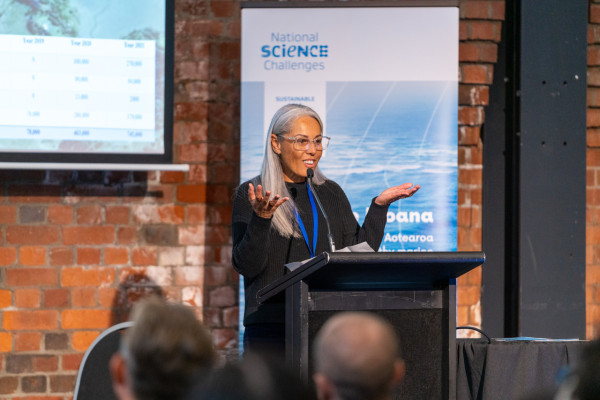
Professor Kura Paul-Burke, University of Waikato
The call from Simon Thrush, University of Auckland, was clear about cumulative effects — we need to move from talking about a ‘cocktail of stressors’ to an ecosystem response.
“It’s not about managing the decline of our biodiversity; it’s about managing its recovery. If we manage with a focus on ecosystems rather than a focus on stressors, we’ll be in a much better place.”
Jasmine Low, the University of Auckland, talked about ‘footprints’ to measure effects and Rebecca Gladstone-Gallagher, the University of Auckland spoke about research into frameworks to help people manage the recovery of marine ecosystems.
Fabrice Stephenson, University of Waikato, spoke about a risk assessment framework to guide decision-makers and help people choose the right tool. This framework recognises the complexities of ecosystems and the need for multiple tools.
Shaun Awatere (Ngāti Porou), Manaaki Whenua, asked people to think about different world views and perspectives when considering risk and uncertainty in decision-making.
Robert Joseph (Tainui, Ngāti Tūwharetoa, Ngāti Kahungunu, Rangitane, Ngāi Tahu), University of Waikato, spoke about needing a new shared vocabulary and prioritising the wellbeing of moana.
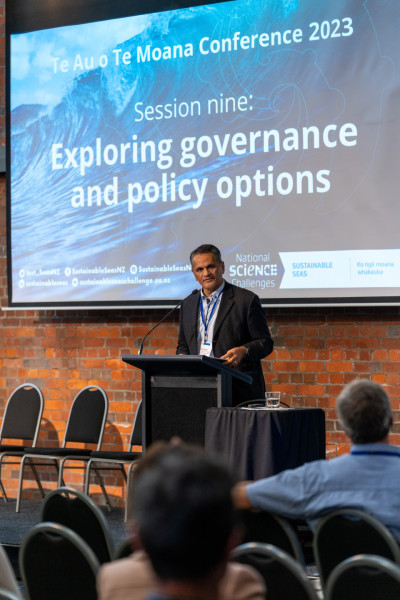
Dr Robert Joseph, University of Waikato
Liz Macpherson, the University of Canterbury, highlighted how current legislation can be used to support ecosystem-based management of the ocean.
Joanne Ellis, University of Waikato, highlighted the need to consider large scale in ecosystem-based management of the ocean.
Drew Lohrer, NIWA, put estuaries at the centre and called for integrated management of freshwater and marine water.
Speakers from session ten, whakatutuki (synthesis), from Cawthron Institute, University of Auckland, and Challenge strand leaders were invited back to the stage for a facilitated discussion led by Chris Cornelisen.
Final thoughts: weaving strands to maximise the research — synthesis for future impact
The finish line for the Challenge is in sight, with 14 months to go until the end of June 2024. The last session of the conference focused participants on bringing the research together to maximise impact, with a laser focus on who will be using the research outputs and tools.
“It’s time to run. We know what’s happening. We know the solutions.” These words from Chris Cornelisen, Cawthron Institute, summarised the sentiment at the end of the conference.
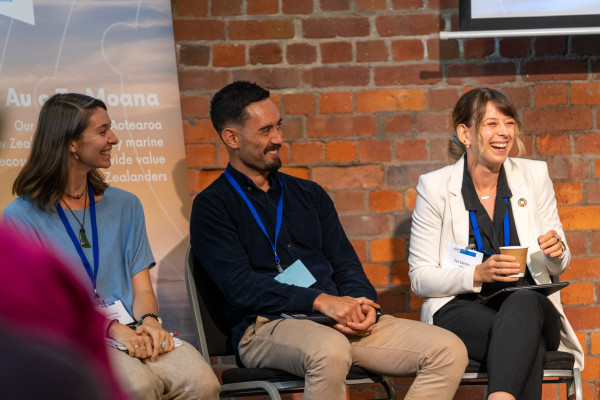
L to R: Natalie Prinz, Sustainable Seas Stakeholder Panel; Darcy Karaka, Sustainable Seas Engagement Advisor; and Eva Siwicka, KPMG, panel discussion on a better future for the ocean
Anne-Maree Schwarz, Ecosystem-based management (EBM) strand leader, said the synthesis team is creating an EBM roadmap that includes a catalogue of tested guidance, frameworks, and tools to support and complement each other based on users’ needs.
“We welcome further discussion and want your ideas as we aim to create a legacy of usable and accessible knowledge from the Challenge.”
The last panel discussion brought younger and more experienced voices together. We heard the youth voice from panellists from the University of Waikato, Sustainable Seas Engagement, and KPMG who answered the question, what does a better future for the ocean look like? Their discussion was followed by panellists from Cawthron Institute, Wellington Regional Council, and Iwi Collective Partnership who tackled the question, how can the Challenge achieve the greatest impact?
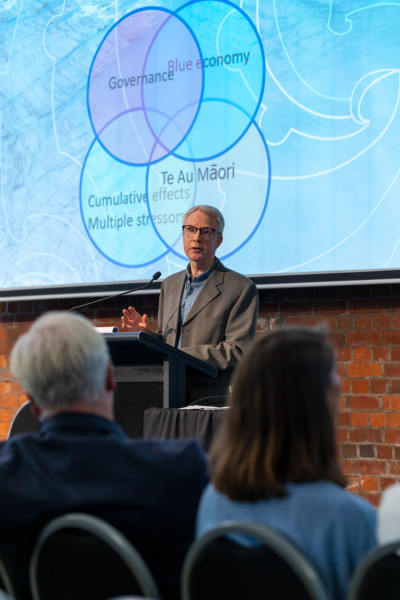
Dr Ian Perry, Chair Sustainable Seas Independent Science Panel
Ian Perry, chair of the Independent Science Panel summed up his synthesis of conference conversations.
“You should be very proud of what you all have accomplished, as I am very proud to be associated with it.”
Conference programme with links to all presentations and discussions
* All photos by Rebecca McMillan Photography